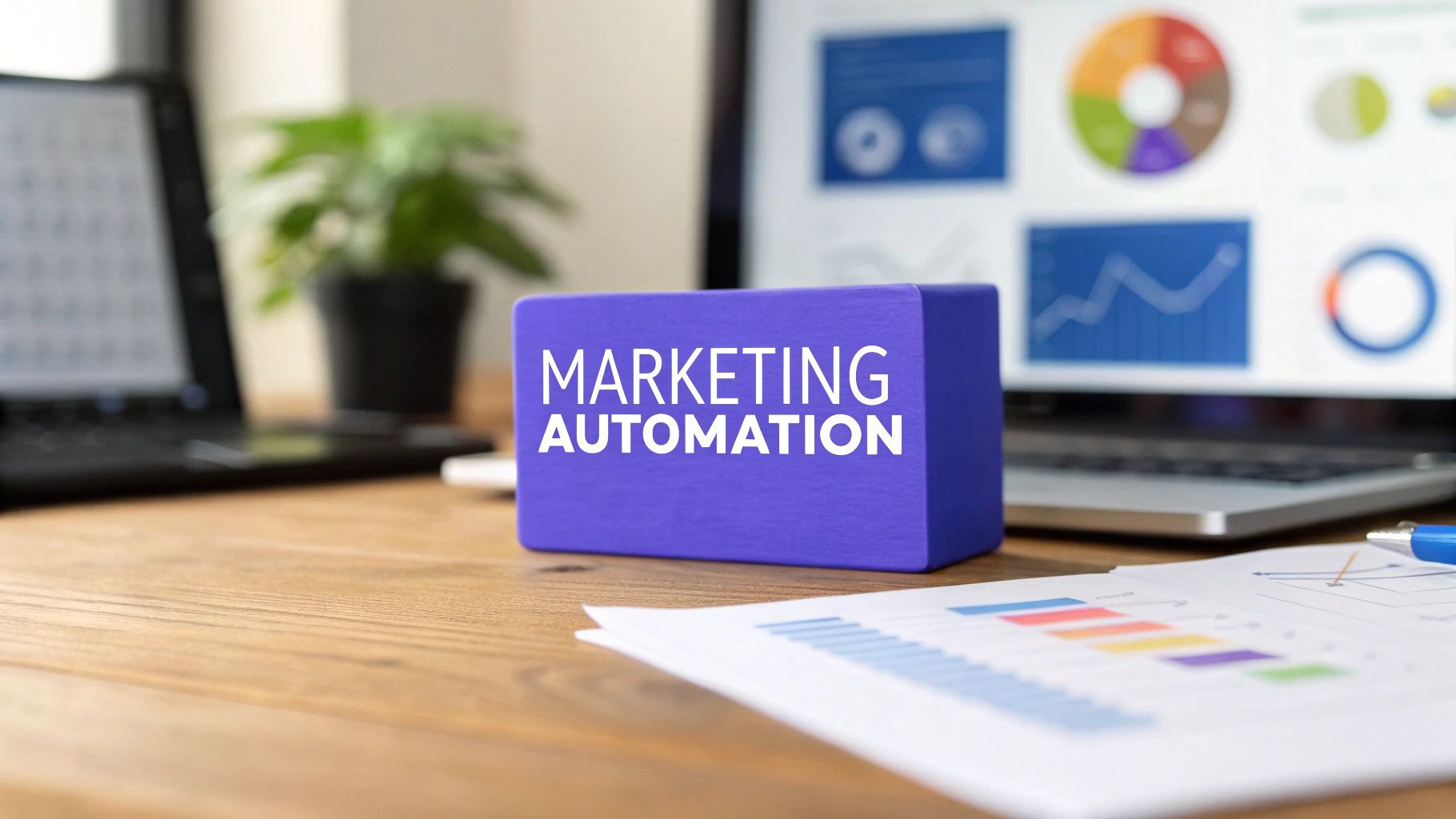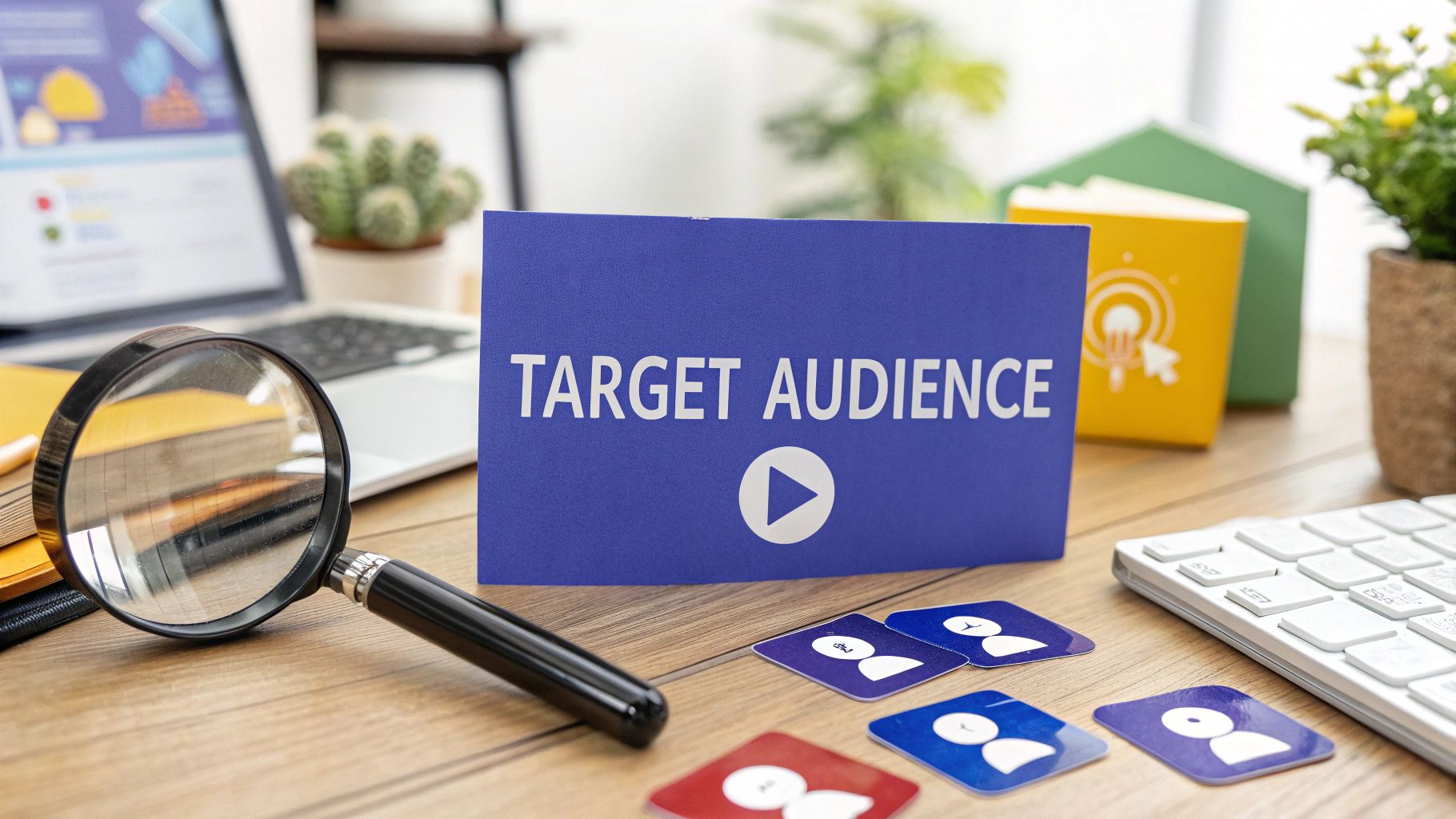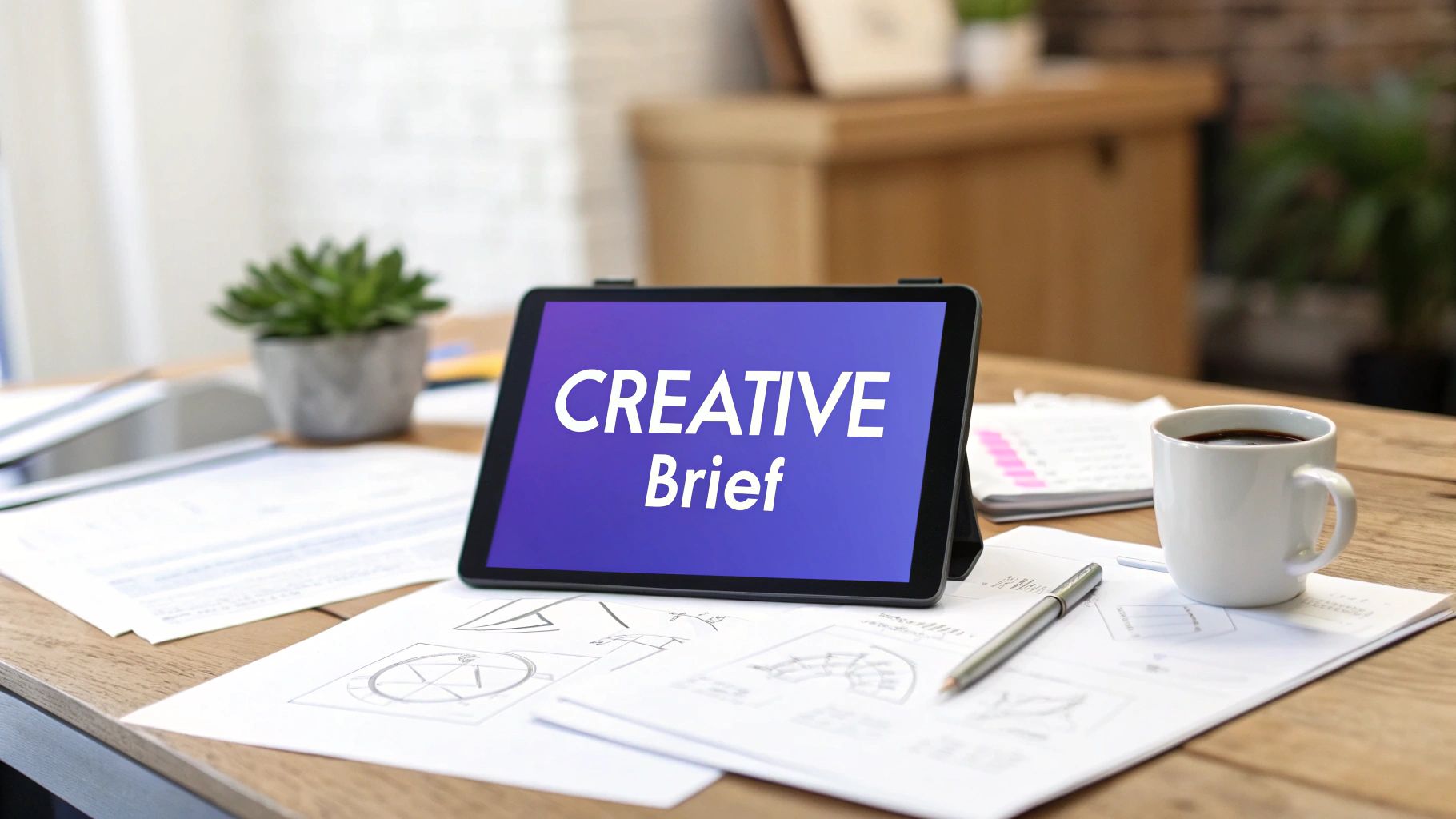In 2024, marketing automation has evolved far beyond simple 'set it and forget it' email sequences. Today, it's the intelligent engine driving personalized customer experiences at scale, aligning sales and marketing, and delivering measurable ROI. Yet, many businesses invest in powerful tools only to see them underutilized, stuck running basic workflows that barely scratch the surface of what's possible. Harnessing its full potential requires a strategic, deliberate approach.
This guide cuts through the noise. We are detailing the essential marketing automation best practices that transform generic campaigns into sophisticated, revenue-generating machines. Moving beyond the obvious, we will provide an actionable blueprint for implementing advanced strategies. This includes everything from dynamic customer segmentation and predictive lead scoring to integrated multi-channel campaign orchestration. The principles are versatile, applying across various sectors; for instance, to understand their strategic application in specific contexts, delve into how marketing automation in higher education can revolutionize enrollment strategies.
Whether you're a small business or a large enterprise, mastering these practices is no longer optional. It's the core differentiator for achieving sustainable growth and building lasting customer relationships. Let's explore the nine key strategies that will unlock the true power of your automation platform.
1. Customer Segmentation and Personalization
The cornerstone of any successful marketing automation strategy is the ability to treat customers as individuals, not as a monolith. Customer segmentation and personalization move beyond generic "one-size-fits-all" campaigns, enabling you to deliver highly relevant messages that resonate deeply. This practice involves dividing your audience into distinct groups based on demographics, purchase history, on-site behavior, and lifecycle stage.
By understanding these segments, you can tailor content, offers, and entire customer journeys to meet their specific needs. For example, a new visitor might receive a welcome email with an introductory offer, while a loyal customer sees recommendations based on past purchases. This level of relevance, famously leveraged by giants like Amazon and Netflix, builds stronger customer relationships and drives significant revenue growth. It’s one of the most critical marketing automation best practices because it directly impacts engagement and conversion rates.
How to Implement Segmentation and Personalization
Getting started doesn't have to be complex. You can build a powerful personalization engine by following a few key steps:
- Start with Broad Segments: Begin by grouping your audience based on basic data like demographics (age, location) or lifecycle stage (new subscriber, repeat customer).
- Implement Dynamic Content: Use your automation platform to create dynamic content blocks within emails. This allows you to show different images, calls-to-action, or product recommendations to different segments within a single campaign.
- Use Progressive Profiling: Gradually collect more data over time using forms that only ask for new information. This enriches customer profiles without overwhelming them with long sign-up processes.
- Maintain Data Hygiene: Regularly clean your contact lists and update segment criteria to ensure your personalization efforts remain accurate and effective.
The following graphic summarizes the powerful impact of a well-executed personalization strategy.
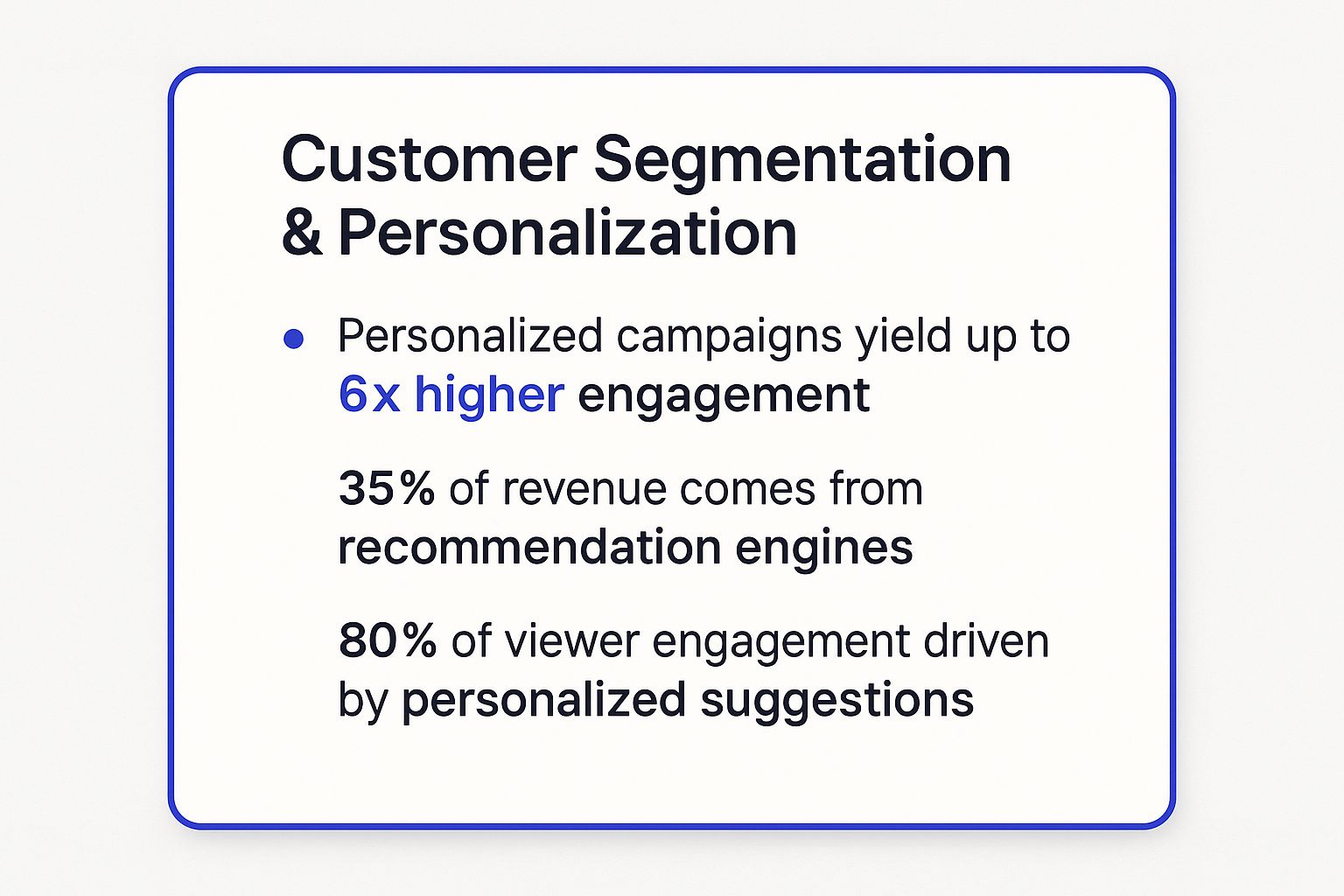
As the data shows, the results of personalization are not just incremental; they are transformative, directly linking tailored experiences to substantial increases in engagement and revenue.
2. Lead Scoring and Nurturing
A critical function of marketing automation is to bridge the gap between marketing efforts and sales readiness. Lead scoring and nurturing provide a systematic framework for this, ranking prospects based on their likelihood to convert and guiding them through the buyer's journey. This practice involves assigning points to leads for specific actions (like opening an email or visiting a pricing page) and demographic attributes, ensuring the sales team focuses only on the most qualified prospects.
By combining this scoring system with automated nurturing workflows, you can deliver timely, relevant content that educates and engages leads until they are sales-ready. For example, a lead who downloads a top-of-funnel ebook enters a nurturing track with related blog posts and case studies, while a lead who requests a demo is immediately flagged for sales outreach. This targeted approach is one of the most impactful marketing automation best practices because it optimizes resource allocation, shortens the sales cycle, and significantly boosts conversion rates.
How to Implement Lead Scoring and Nurturing
Building an effective lead management system requires close alignment between marketing and sales. You can create a powerful process by following these key steps:
- Define Your Ideal Customer Profile (ICP): Collaborate with the sales team to clearly define the characteristics and behaviors of a qualified lead. This forms the foundation of your scoring criteria.
- Assign Point Values: Set up a scoring model that assigns positive points for engagement signals (e.g., +10 for a demo request) and negative points for disqualifying actions (e.g., -20 for an unsubscribed email).
- Create Multiple Nurturing Tracks: Develop distinct automated email sequences for different lead segments, personas, or stages in the buying funnel. This ensures the content is always relevant to their needs.
- Review and Adjust Regularly: Analyze which leads convert to customers and refine your scoring criteria accordingly. Regularly review your model to ensure it remains accurate and predictive.
3. Multi-Channel Campaign Orchestration
Modern customers interact with brands across a vast array of touchpoints, from email and social media to SMS and mobile apps. Multi-channel campaign orchestration is the practice of strategically coordinating these interactions to create a single, seamless conversation. This approach ensures that your messaging is consistent and contextually relevant, regardless of the channel a customer uses to engage. It moves beyond simply being present on multiple platforms to creating a unified, intelligent journey.
This strategy is one of the most powerful marketing automation best practices because it meets customers where they are, creating a cohesive brand experience that builds trust and loyalty. For instance, a customer who abandons a cart on your website could receive a follow-up email, see a retargeting ad on social media, and get a push notification with a special offer via your mobile app. This coordinated effort, mastered by brands like Starbucks and Nike, significantly increases the likelihood of conversion by reinforcing the message across preferred channels.
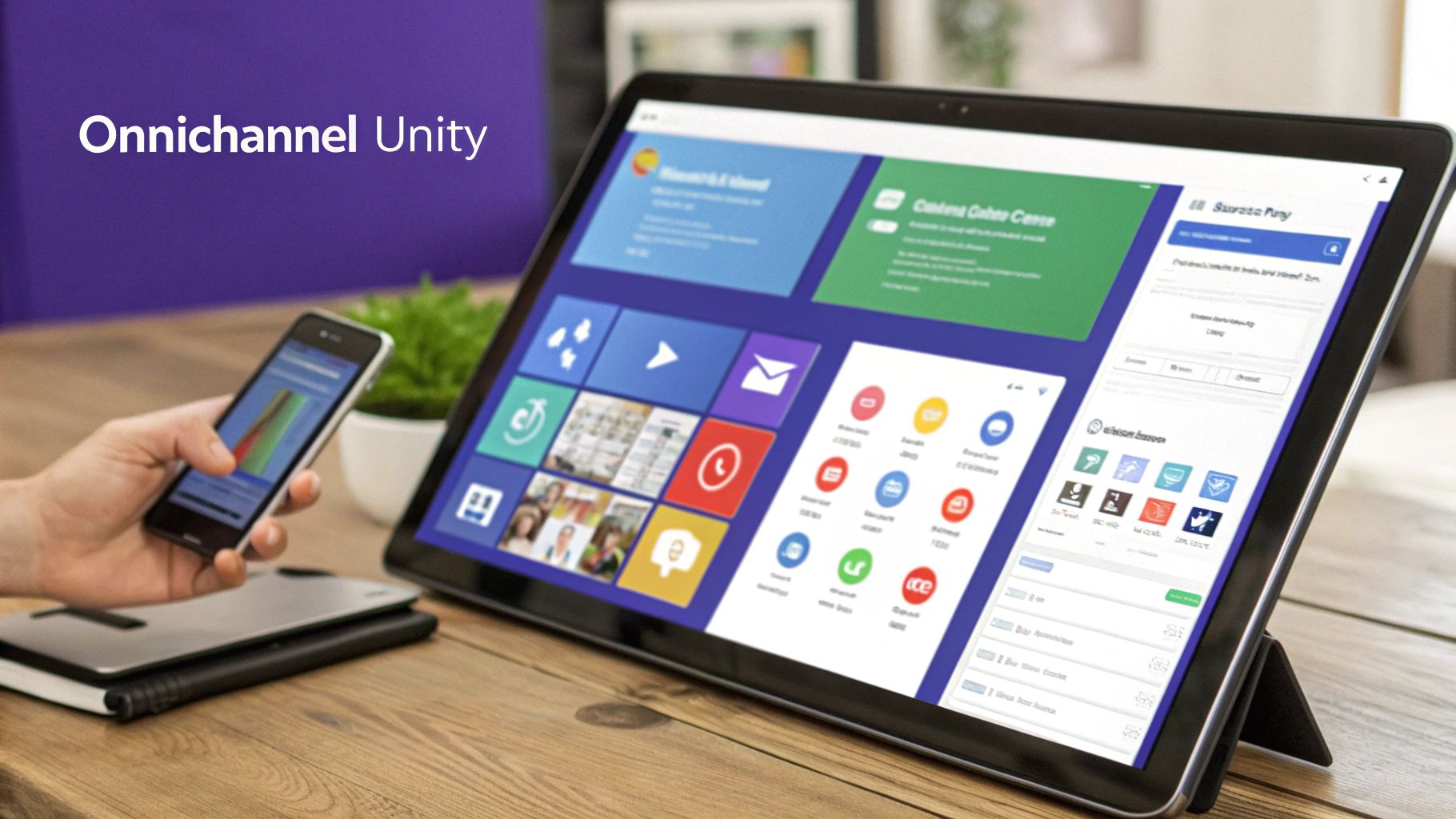
How to Implement Multi-Channel Orchestration
Creating a truly unified customer experience requires careful planning and a centralized data strategy. Here are the essential steps to get started:
- Map Customer Journeys: Begin by outlining all potential customer touchpoints across every channel. Understand how users move between them to identify opportunities for seamless transitions.
- Centralize Your Data: Use a customer data platform (CDP) or a robust CRM to create a single, unified view of each customer. This ensures that actions on one channel inform the communications on another.
- Define Channel Roles: Determine the primary purpose of each channel. For example, use SMS for urgent, time-sensitive alerts, email for detailed content, and social media for brand building and community engagement.
- Test and Optimize Channel Mix: Use your automation platform's analytics to track which channel combinations drive the best results for different segments and campaigns, then refine your strategy accordingly.
By orchestrating campaigns across multiple fronts, you create a powerful, persistent brand presence that resonates more effectively. For a deeper dive into how leading brands structure their campaigns, you can explore some impressive multi-channel marketing campaign examples and draw inspiration for your own strategy.
4. Behavioral Trigger Automation
Moving beyond static campaigns, behavioral trigger automation allows you to create real-time, contextually relevant conversations with your audience. This practice involves setting up automated responses to specific customer actions, such as visiting a key webpage, opening an email, or abandoning a shopping cart. It transforms marketing from a monologue into a dynamic dialogue, responding directly to customer intent the moment it's expressed.
For instance, Amazon's legendary abandoned cart emails, which recover significant lost revenue, are a prime example of this strategy in action. Similarly, Netflix uses viewing behavior to trigger personalized content recommendations, keeping users engaged. Implementing these types of triggers is one of the most effective marketing automation best practices because it capitalizes on high-intent moments, leading to dramatically higher engagement and conversion rates.

How to Implement Behavioral Trigger Automation
You can start leveraging this powerful technique by identifying and acting on key customer behaviors. Here’s how to get started:
- Start with High-Intent Behaviors: Focus first on triggers that signal strong purchase intent, like cart abandonment or viewing a product multiple times. These are often the easiest to implement and offer the highest immediate return.
- Set Appropriate Timing Delays: Not every trigger requires an instant response. Test different timing delays for your messages. A cart abandonment email sent an hour later may feel helpful, while one sent after a minute could feel intrusive.
- Personalize Trigger Messages: Use the behavioral data that initiated the trigger to personalize the message. If a user viewed a specific product, include that product's name and image in your follow-up email.
- Implement Fatigue Rules: To avoid overwhelming your audience, set up rules that limit how many triggered messages a single contact can receive within a certain period. This maintains a positive customer experience.
The following video from ActiveCampaign provides a deeper look into the mechanics of setting up and optimizing automation triggers.
By aligning your marketing actions with customer behaviors, you create a more responsive, relevant, and ultimately more profitable customer journey.
5. Data Integration and Clean Data Management
The engine of any high-performing marketing automation system runs on clean, reliable data. Data integration and clean data management are the practices of consolidating information from various sources into a single, unified view of the customer. This ensures that every automated action, from email sends to ad targeting, is based on accurate, complete, and up-to-date information, preventing misfires and missed opportunities.
Without this foundation, even the most sophisticated workflows will fail. Imagine sending a "Welcome" email to a decade-long customer or recommending products they just purchased. Such errors, born from fragmented data, erode trust and waste resources. Platforms like Segment and Tealium have popularized the concept of a Customer Data Platform (CDP) precisely to solve this issue, unifying data from CRMs, e-commerce platforms, and analytics tools. This approach is one of the most fundamental marketing automation best practices because accuracy is non-negotiable for effective personalization.
How to Implement Data Integration and Clean Data Management
Building a unified and clean data ecosystem is a strategic process that requires deliberate effort. Here are the key steps to get started:
- Audit Your Data Sources: Begin by mapping out every platform where customer data lives, from your CRM and email service provider to your e-commerce store and help desk software. Identify where data is duplicated or conflicting.
- Establish Data Governance: Create clear rules and procedures for how data is collected, stored, and managed. Define who is responsible for data quality and what the standards are for key fields.
- Implement Regular Data Cleansing: Schedule routine processes to de-duplicate contacts, correct formatting errors, and remove inactive or invalid records. Use your automation platform's validation rules to enforce standards from the start.
- Use Data Enrichment Services: Enhance your customer profiles by using third-party services to fill in missing information like company size, job title, or industry, allowing for more precise segmentation and targeting.
6. A/B Testing and Continuous Optimization
Guesswork has no place in a high-performing marketing strategy. A/B testing and continuous optimization provide a systematic, data-driven framework for improving every aspect of your campaigns. This practice involves creating variations of a single element, such as an email subject line or a call-to-action button, and testing them against each other to determine which version performs better. By isolating variables, you can make incremental improvements that compound over time.
This approach is one of the most powerful marketing automation best practices because it replaces assumptions with empirical evidence. Giants like Netflix test thumbnails to increase viewership, while Booking.com famously runs over a thousand tests simultaneously to refine its user experience. The goal is to create a culture of constant experimentation where every campaign is an opportunity to learn and enhance performance, directly boosting key metrics like open rates, click-through rates, and conversions.
How to Implement A/B Testing and Optimization
Integrating a testing mindset into your automation workflows is straightforward and highly impactful. Focus on a methodical approach to gather clear, actionable insights.
- Test One Element at a Time: To get clean data, only change one variable per test. For example, test two different subject lines while keeping the email content identical.
- Start with High-Impact Elements: Begin your testing on elements that have the biggest potential impact on your goals, such as email subject lines, headlines, and calls-to-action (CTAs).
- Ensure Statistical Significance: Don’t end a test prematurely. Allow it to run long enough to collect sufficient data to ensure the results are statistically significant, not just due to random chance.
- Document and Learn: Maintain a log of all your tests, including the hypothesis, results, and what you learned. This creates an invaluable internal resource for future campaigns. To further refine your campaigns and website experience, delve into these valuable insights on A/B Testing Best Practices.
7. Customer Lifecycle Marketing
Effective marketing automation extends beyond one-off campaigns; it involves nurturing relationships throughout the entire customer journey. Customer lifecycle marketing is a strategic approach that maps distinct marketing activities to specific stages, from a prospect's initial awareness to their evolution into a loyal brand advocate. This ensures that every communication is timely, relevant, and appropriate for where the customer is in their relationship with your brand.
By aligning your automation with the natural progression of a customer, you can systematically build trust and maximize lifetime value. For instance, platforms like HubSpot have perfected this by guiding users from initial contact (Awareness) through to educational content (Consideration) and finally to a purchase decision (Decision), with post-purchase nurturing to foster loyalty. This is one of the most powerful marketing automation best practices because it transforms marketing from a series of disjointed tactics into a cohesive, value-driven journey.
How to Implement Customer Lifecycle Marketing
Building a successful lifecycle strategy requires a clear understanding of your customer's path and the right content to support them at each step.
- Map Your Customer Journey: Clearly define the stages of your customer lifecycle (e.g., Awareness, Consideration, Purchase, Retention, Advocacy) and identify the key touchpoints and triggers for moving between them.
- Create Stage-Specific Content: Develop a library of content tailored to each stage. This could include blog posts and guides for awareness, case studies and webinars for consideration, or exclusive offers and loyalty programs for retention.
- Implement Win-Back Campaigns: Use automation to identify and re-engage dormant or at-risk customers with targeted offers or personalized check-ins, preventing churn before it happens.
- Measure with Lifecycle KPIs: Track metrics specific to each stage, such as lead-to-customer conversion rate, customer lifetime value (CLV), and repeat purchase rate, to gauge the effectiveness of your strategy.
8. Sales and Marketing Alignment (SMarketing)
Marketing automation is not just a tool for the marketing department; its true power is unleashed when it bridges the gap between marketing and sales. This strategic alignment, often called "SMarketing," involves creating a cohesive unit focused on shared goals, processes, and technology. It ensures a seamless customer journey from initial awareness to final purchase by eliminating the common friction points where leads are lost or mishandled.
By integrating these two functions, companies create a closed-loop system where marketing generates and nurtures qualified leads, and sales provides feedback on lead quality. This synergy, famously championed by platforms like HubSpot, transforms the customer acquisition process from a relay race into a unified team effort. Aligning sales and marketing is one of the most impactful marketing automation best practices because it directly boosts pipeline quality, shortens the sales cycle, and accelerates revenue growth.
How to Implement Sales and Marketing Alignment
Building a strong SMarketing foundation requires a commitment to collaboration and shared accountability. You can start by implementing a few key initiatives:
- Establish a Service Level Agreement (SLA): Create a formal agreement that defines each team's responsibilities, including marketing's lead generation quotas and sales' follow-up commitments.
- Develop Shared Definitions: Work together to create a universal definition for a "marketing qualified lead" (MQL) and a "sales qualified lead" (SQL). Implement a lead scoring model that both teams agree on and trust.
- Integrate Your Technology: Ensure your marketing automation platform and CRM are tightly integrated. This allows for seamless lead handoffs and provides both teams with a complete view of the customer's history. For more on this, explore tools that facilitate marketing collaboration.
- Hold Regular Alignment Meetings: Schedule weekly or bi-weekly "SMarketing" meetings to review shared dashboards, discuss campaign performance, celebrate joint wins, and troubleshoot challenges together.
9. Performance Analytics and Attribution Modeling
Executing automated campaigns without measuring their impact is like navigating without a map. Performance analytics and attribution modeling provide the essential data-driven feedback loop, allowing you to understand which efforts are truly driving results. This practice involves systematically tracking campaign performance, connecting marketing actions to customer conversions, and calculating return on investment (ROI). It's about moving beyond vanity metrics and focusing on what generates revenue.
By analyzing which touchpoints and channels contribute most effectively to the customer journey, you can make smarter strategic decisions. For instance, platforms like Google Analytics 4 and HubSpot provide advanced attribution reports that help businesses optimize spend and improve marketing ROI. Adopting this approach is one of the most vital marketing automation best practices because it transforms your strategy from guesswork into a precise, data-backed science.
How to Implement Analytics and Attribution
Building a robust measurement framework is crucial for continuous improvement. You can get started by focusing on these foundational steps:
- Start with Simple Attribution Models: Begin with a first-touch or last-touch model to understand the initial and final interactions that lead to conversions before moving to more complex multi-touch models.
- Implement Consistent UTM Tracking: Use UTM parameters across all campaigns (email, social, ads) to ensure you can accurately trace traffic sources and user behavior back to specific marketing activities.
- Set Up Conversion Tracking: Ensure key conversion goals, such as form submissions or purchases, are properly configured and tracked across your website and landing pages.
- Create Regular Reporting Schedules: Establish a routine for reviewing performance data weekly or monthly. This helps you identify trends, spot issues early, and make timely optimizations. To learn more about this in depth, check out these marketing performance metrics examples.
Marketing Automation Best Practices Comparison
| Practice | 🔄 Implementation Complexity | ⚡ Resource Requirements | 📊 Expected Outcomes | 💡 Ideal Use Cases | ⭐ Key Advantages |
|---|---|---|---|---|---|
| Customer Segmentation and Personalization | High - requires data collection & management | High - data, tools, compliance efforts | Up to 6x higher engagement, better ROI | Personalizing messaging for distinct audience groups | Highly relevant, improved customer loyalty |
| Lead Scoring and Nurturing | Medium - ongoing refinement needed | Medium - integration with CRM & sales | 50%+ sales efficiency increase, shorter cycles | Prioritizing leads and automating engagement | Sales-marketing alignment, time-saving automation |
| Multi-Channel Campaign Orchestration | High - complex setup & tech integration | High - multiple channels & platforms | Higher reach & conversion, improved brand consistency | Coordinating messages across email, social, SMS, apps | Seamless experiences, reduced message fatigue |
| Behavioral Trigger Automation | Medium-High - needs tracking & conditional logic | Medium - tracking infrastructure | Higher conversion & timely responses | Real-time engagement based on user actions | Immediate, relevant messaging, resource efficient |
| Data Integration and Clean Data Management | High - technical setup & ongoing maintenance | High - skilled resources & tools | Improved targeting accuracy & compliance | Maintaining accurate data for all automation | Reduces errors, supports GDPR/CCPA, better analytics |
| A/B Testing and Continuous Optimization | Medium - requires traffic & rigorous testing | Medium - tools & analysis efforts | Continuous campaign performance improvement | Testing elements like subject lines, content | Data-driven decisions, improved ROI |
| Customer Lifecycle Marketing | High - complex design & multiple content types | High - ongoing content & data efforts | Maximized lifetime value & retention | Stage-based messaging throughout customer journey | Stronger relationships, upsell and retention |
| Sales and Marketing Alignment (SMarketing) | Medium - cultural change & system integration | Medium - collaborative tools & meetings | Increased conversion, faster follow-up | Aligning sales and marketing processes | Better lead quality, accountability, revenue growth |
| Performance Analytics and Attribution Modeling | High - complex modeling & analytics expertise | High - data, tools, and analysis | Clear ROI visibility, better budget decisions | Measuring campaign effectiveness & ROI | Predictive insights, data-driven optimization |
Your Next Step: From Practice to Performance
You've just explored the nine pillars that support a world-class marketing automation strategy, from granular customer segmentation to sophisticated attribution modeling. The journey through these marketing automation best practices isn't about simply checking boxes; it's about fundamentally transforming how you engage with your audience at every stage of their journey. Moving forward, the goal is to shift from a mindset of manual campaign execution to one of building an intelligent, automated, and continuously improving marketing ecosystem.
The true power of this framework lies not in adopting a single practice, but in the synergy created when they work in concert. A clean, integrated data foundation (Practice #5) fuels more accurate lead scoring (Practice #2). This, in turn, allows you to deliver highly personalized, behaviorally triggered campaigns (Practices #1 and #4) across multiple channels (Practice #3). This cohesive approach is what elevates your efforts from a series of disconnected tactics to a unified customer experience engine.
Turning Knowledge into Actionable Strategy
The sheer scope of these practices can feel overwhelming, but progress is achieved through focused, iterative steps. Don't attempt to implement everything at once. Instead, identify your most significant bottleneck and start there.
- Is your sales team complaining about lead quality? Prioritize implementing a robust lead scoring model and work on aligning sales and marketing (SMarketing).
- Are your email engagement rates dropping? Focus on deeper segmentation and launching your first A/B tests to optimize messaging and timing.
- Do you struggle to prove marketing's ROI? Begin by defining your key performance metrics and exploring a suitable attribution model to connect your efforts to revenue.
This incremental approach ensures that each new practice you adopt is built on a solid foundation, creating sustainable momentum and delivering measurable results faster. The key is to view your marketing automation platform not as a set-it-and-forget-it tool, but as the central nervous system of your growth strategy. It requires regular attention, optimization, and a commitment to leveraging data to make smarter decisions.
By embracing these marketing automation best practices, you empower your team to move beyond repetitive tasks and focus on what truly matters: understanding the customer, crafting compelling narratives, and building lasting relationships. This is how you transform your marketing from a cost center into a predictable, scalable, and indispensable driver of business growth.
Ready to master multi-channel orchestration? PostSyncer integrates seamlessly with your existing marketing stack, allowing you to incorporate powerful social media automation into your workflows and create a truly unified customer experience. Discover how you can elevate your strategy by visiting PostSyncer today.
